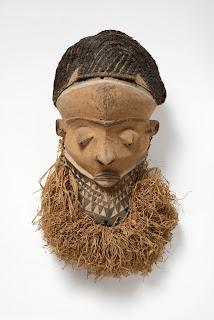 |
|
Henri Matisse, Safrano
Roses at the Window, 1925
Oil on canvas, 80 x
65 cm
Private collection
Photo © Private
collection
© Succession H.
Matisse/DACS 2017
|
What inspires an artist? For Van Gogh, it ranged from
sunflowers to the village of Auvers-sur-Oise, where his life ended. Constable loved
Flatford Mill and the Suffolk countryside, Degas had his dancers while Cezanne painted
Mont Sainte Victoire many times. Matisse,
we discover in this Royal Academy exhibition, loved what might be called bric-a-brac
- items mostly with little material worth, but which had caught his eye. This
innovative presentation brings together thirty-five of the objects he owned, many not
publicly seen outside France before, and pairs them with sixty-five of the
works in which they appear. Matisse once described his collection as a ‘working library’,
suggesting they functioned as a resource to which he regularly returned. He
took them with him from studio to studio, rearranging and studying them. “These
objects keep me company ..... I am not alone”, he wrote to his wife.
At the
start of the exhibition is a simple blue Andalusian glass vase, bought in 1912.
He painted it several times, (top) usually filled with flowers. In one painting on
display, it is shown in a soft light that filters through the window and a lace
curtain. In another, sharper light makes it seem heavier and more opaque.
“A good actor can have a part in ten different plays; an object can play a role
in ten different pictures,” he explained.
 |
|
Unknown, Coffee
Pot, France, early 19th Century
Silver, handle in
wood, 14 x 10.9 x 10.9 cm
Musée Matisee, Nice
Photo © François Fernandez, Nice
|
Perhaps the most famous ‘actor’ in
his cast of treasured items was a wedding present, a silver pot for making chocolate.
It is included in various still-lifes, occasionally even serving as a vase. The shape must have really appealed to him - he bought a second one and many years later featured it as a cutout in Still Life with a Shell.
The
exhibition also explores Matisse’s fascination with African artefacts. In 1908 he
bought his first African sculpture from a dealer in Paris. He showed it to
Picasso, and later remarked that “it was then when Picasso noticed negro
sculpture”.
Another section of the exhibition is entitled The Studio as Theatre. In 1910 Matisse travelled to Germany for an exhibition,
Masterpieces of Mohammedan Art. It included tapestries, reliefs, metalwork and
other decorative arts produced in the near East. He loved their intricate and
colourful decoration, and was inspired to take trips to southern Spain and
North Africa. Using the embellished fabrics and elaborate furniture he collected,
he transformed his studio into a theatrical set.
The visitor can see the
original perforated wall hanging, a ‘haiti’ (above) that, in a painting of an interior
with his daughter, Marguerite and a model, becomes a Moorish screen.
 |
|
Henri Matisse, The
Moorish Screen, 1921
Oil on canvas, 91 x
74 cm
Philadelphia Museum
of Art. Bequest of Lisa Norris Elkins, 1950
Photo © Philadelphia
Museum of Art/Art Resource, NY
|
In 1941, an
operation for cancer left Matisse weak and mostly confined to his bed or a
wheelchair. Unable to paint, he began experimenting with cut paper on a large
scale. The shapes were fixed to the studio walls, having more in common with an
installation or mural than an easel painting. His wife gave him a Chinese
calligraphy panel for his 60th birthday and he was fascinated by the
connection between form and meaning. Later, almost at the end of his career, he
described his cut-outs as a summation of his life-long struggle to represent
meaning in the least complicated way possible. The panel is featured in the
exhibition’s final section, The Language of Signs, surrounded by cut-out
elements. Looking at them, and the other items brought together for this illuminating exhibition, you really do see Cezanne’s mind at work.
Matisse in the Studio. Royal Academy of Arts, until Nov 12 2017 Admission £15.50 (concessions available)






Paul and I really enjoyed this reminder of Matisse's inspirations thanks Sandra.
ReplyDeleteSo pleased. It will still be on when you are here.
ReplyDelete